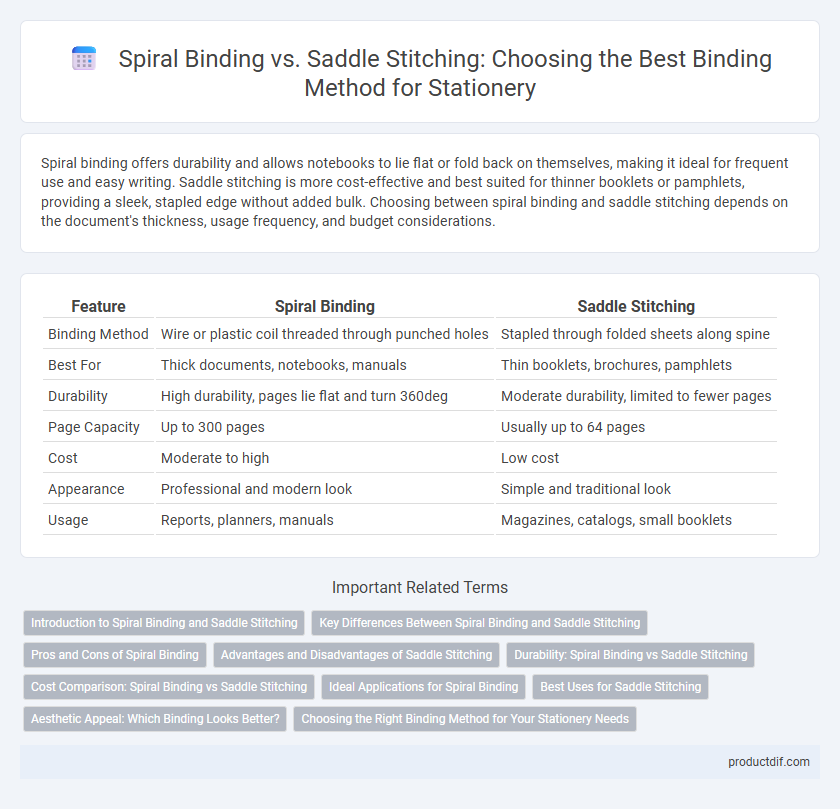Spiral binding offers durability and allows notebooks to lie flat or fold back on themselves, making it ideal for frequent use and easy writing. Saddle stitching is more cost-effective and best suited for thinner booklets or pamphlets, providing a sleek, stapled edge without added bulk. Choosing between spiral binding and saddle stitching depends on the document's thickness, usage frequency, and budget considerations.
Table of Comparison
| Feature | Spiral Binding | Saddle Stitching |
|---|---|---|
| Binding Method | Wire or plastic coil threaded through punched holes | Stapled through folded sheets along spine |
| Best For | Thick documents, notebooks, manuals | Thin booklets, brochures, pamphlets |
| Durability | High durability, pages lie flat and turn 360deg | Moderate durability, limited to fewer pages |
| Page Capacity | Up to 300 pages | Usually up to 64 pages |
| Cost | Moderate to high | Low cost |
| Appearance | Professional and modern look | Simple and traditional look |
| Usage | Reports, planners, manuals | Magazines, catalogs, small booklets |
Introduction to Spiral Binding and Saddle Stitching
Spiral binding uses a continuous plastic or metal coil threaded through punched holes along the document's edge, offering durability and the ability to lay flat or fold back pages completely. Saddle stitching involves folding sheets and stapling them through the spine, making it ideal for thinner booklets and magazines with a professional, concise finish. Both methods cater to different project needs, with spiral binding preferred for flexibility and saddle stitching for economical and straightforward assembly.
Key Differences Between Spiral Binding and Saddle Stitching
Spiral binding uses a continuous plastic or metal coil threaded through holes punched along the paper edge, allowing pages to lie flat and rotate 360 degrees, ideal for notebooks and reports requiring frequent use. Saddle stitching involves folding sheets in half and stapling them along the spine, providing a cost-effective solution for thinner booklets or brochures with up to 64 pages but limiting flatness and page turn flexibility. The choice depends on project thickness, durability needs, and budget constraints, with spiral binding offering greater longevity and saddle stitching favored for simplicity and economy.
Pros and Cons of Spiral Binding
Spiral binding offers durability and allows pages to lay completely flat, making it ideal for notebooks, manuals, and presentations that require frequent handling or note-taking. It accommodates thick documents better than saddle stitching and provides easy page-turning without risk of tearing. However, spiral binding can be more expensive and bulky compared to saddle stitching, and the exposed spiral may catch on objects or become deformed over time.
Advantages and Disadvantages of Saddle Stitching
Saddle stitching offers a cost-effective and quick binding method ideal for small booklets, brochures, and magazines up to 64 pages due to its ability to lay flat. Its main disadvantage is limited durability and page count capacity, making it unsuitable for thicker publications or heavy usage. The binding can also cause inner pages to curve slightly, affecting the overall presentation quality.
Durability: Spiral Binding vs Saddle Stitching
Spiral binding offers superior durability compared to saddle stitching, as its plastic or metal coils securely hold pages together, preventing them from easily falling out. Saddle stitching, which involves stapling folded sheets along the spine, is more prone to wear and tear, making it less suitable for thick documents or long-term use. For projects requiring frequent handling and extended lifespan, spiral binding is the preferred method due to its resilience and ability to accommodate larger page counts.
Cost Comparison: Spiral Binding vs Saddle Stitching
Spiral binding generally incurs higher costs than saddle stitching due to the materials and machinery involved, with prices ranging from $2 to $5 per book depending on volume and wire type. Saddle stitching remains the most economical option for shorter publications, often costing under $1 per unit, especially in large print runs. Cost efficiency in spiral binding increases with thicker documents and customization needs, while saddle stitching is optimal for budget-conscious projects with fewer pages.
Ideal Applications for Spiral Binding
Spiral binding is ideal for notebooks, manuals, and calendars that require durability and the ability to lay flat for easy writing or viewing. It supports frequent page turning and adds flexibility, making it suitable for workbooks, presentations, and reports that need to stay open without effort. This binding method accommodates thick documents and allows pages to rotate a full 360 degrees, enhancing usability in educational and professional environments.
Best Uses for Saddle Stitching
Saddle stitching is best suited for smaller booklets, brochures, and magazines with up to 64 pages due to its cost-effectiveness and quick turnaround. It provides a clean, professional appearance ideal for marketing materials, programs, and reports that do not require a thick spine. The method's ability to lie relatively flat when open enhances readability, making it perfect for short-run projects and lightweight documents.
Aesthetic Appeal: Which Binding Looks Better?
Spiral binding offers a modern and professional aesthetic with visible coils that enhance the book's durability and allow pages to lie flat, making it ideal for notebooks and manuals. Saddle stitching provides a sleek and minimalist appearance with its folded staples, creating a clean and polished look commonly used in magazines and brochures. Choosing between the two depends on the desired presentation style and the type of publication being produced.
Choosing the Right Binding Method for Your Stationery Needs
Spiral binding offers durability and allows pages to lay flat, making it ideal for notebooks and manuals requiring frequent handling. Saddle stitching is cost-effective and best suited for thinner booklets, brochures, or catalogs with fewer pages. Selecting the right binding method depends on factors such as page count, budget, and the intended use of your stationery product.
Spiral binding vs Saddle stitching Infographic

 productdif.com
productdif.com